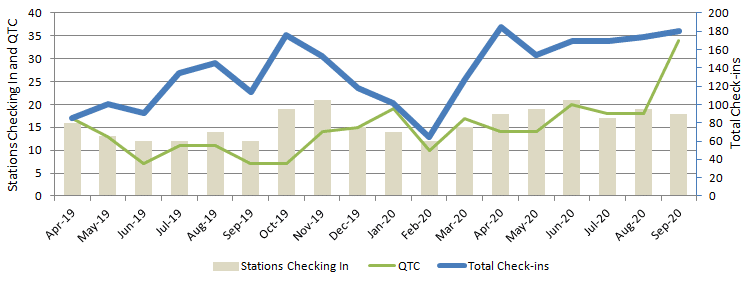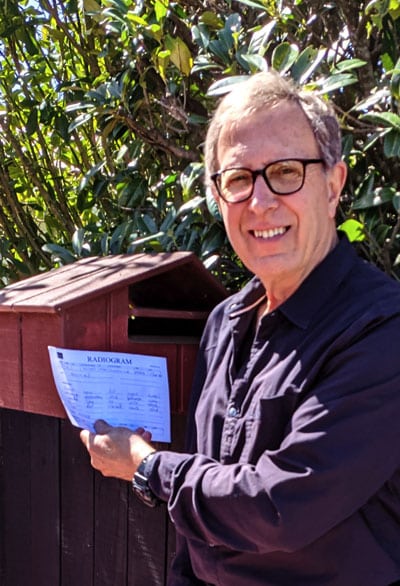This is a fortnightly newsletter about the New Zealand Net. If you would like to be notified by email when a new edition is published, please contact ZL1NZ.
Browse our newsletter archive.
Featured keys

Check out these sharp looking keys made by net member Gerard ZL2GVA, who explains:
“The small straight one is a design mix of several ‘mini’ keys that I found info on, and turned into my version. The paddles are the K8FF design.”
Nice work Gerard!
Quick notes

Are your aerials still up? We certainly got plenty of warning about this week’s fierce storm, which brought snow and sub-zero temperatures to parts of the South Island. Here in Auckland we barely felt a bit of extra breeze, although I noticed that the Harbour Bridge was closed for a while (they don’t take chances these days, do they!) and the laundry seemed to dry faster than usual.
Steve ZL2KE in Masterton is our new Net Control Station on Thursday nights. Steve was first licensed in 1963 in the USA. A long-time CW man, he has also taught CW Academy students. Steve has lived in New Zealand since 1975, so you know he’s a clever chap. 🙂
Thanks to Dave ZL4LDY who has been doing Thursday Net Control, and can now cut back to just Fridays.
The 400th session of NZ Net has just concluded (Friday 2 October) and a special message was sent to all stations. What shall we do to celebrate our 500th?
The Straight Key Century Club QSO party is this weekend, from 1800Z Saturday to 1800Z Sunday.
Cartoon: Philip ‘Gil’ Gildersleeve
Net numbers

It was a great month for traffic on NZ Net, with 34 messages being exchanged, and we had a couple of sessions with 5 pieces of traffic. Total check-ins were strong, at 180. The number of stations checking in at least once during the month has been fairly static at around 18, so please help us expand the net by telling your friends about all the fun to be had!
Here is the net report, sent to all stations during the 1 October net:
NR73 R ZL1NZ 45/42 AUCKLAND 0800Z 1OCT20 = NZ NET = SEPT QNI ZL1AJY 5 ZL1ANY 20 ZL1BWG 14 ZL1NZ 22 ZL1PC 6 ZL2GD 13 ZL2GVA 16 ZL2KE 17 ZL2LN 11 ZL2WT 11 ZL3RIK 1 ZL3RX 1 ZL4CU 6 ZL4FZ 1 ZL4KX 4 ZL4LDY 9 VK3DRQ 19 VK4PN 4 TOTAL 180 QTC 34 = ZL1NZ
Special delivery

Steve ZL2KE
By Steve ZL2KE
What a complete surprise to receive a radiogram in our letterbox! I have only received one previously and that must have been around 50 years ago.
When I brought the mail in to our kitchen where my XYL was, I said “Have a look at this!” She looked puzzled for a moment and then said she thought that telegrams stopped a long time ago. Ha! When I explained what it was she had a glazed expression that we hams often get when people do not understand what our hobby is all about! Never mind, she tolerates my CW activities very well.
Thanks to Neil ZL1NZ who sent the radiogram and especially to Stephen ZL1ANY who printed and put it in the letter box. He lives a couple of kilometres from me but has never been to my QTH – so I am impressed by his efforts!
After hearing about Steve’s ‘special delivery’ I asked Stephen ZL1ANY to tell us about what he had done:
On the net that night (Friday 19 September) I heard there was traffic for ZL2KE, but I did not hear him check in, so when Net Control ZL4LDY asked “QNW ZL2KE?” (how do I route traffic to ZL2KE?) I offered to handle it.
I had met Steve at the club a couple of times and worked him for the first time a few days previously on 80m CW so I thought I could QSP. I copied the message, and tried calling him on 80 CW a couple of times, but was unsuccessful. So I looked up his address in the callbook, filled in the radiogram form including the bit at the bottom indicating the handling station for QSP.
I happened to be heading over his way on Saturday morning so I dropped it in his letter box, which just happens to be opposite the hospice where they have a regular Saturday morning second-hand fete. (I recently obtained a nice piece of plastic pipe there, which I used for a loading coil for my EFHW which will I hope be my portable antenna when I travel.)
My final question to Stephen was “did you deliver the radiogram on a bicycle like the old-time telegraph messengers?”
No, it was in a Prius! But Masterton is flat and I do have a bike – with a bell – so I will endeavour to correct this fault next time. 🙂
Morse musings
Did you know that the end-of-message signal <AR>, or “AR Barred”, is also the plus symbol (+)?
I can think of one other Morse symbol with two meanings: <IMI> means “I repeat” or it can be a question mark. Please let me know if you have found others!
So, why do we use <AR> to indicate the end of a message? That one is easy to answer.
In American Morse, the end-of-message signal is FN (“finish”). The F in American Morse is di-dah-dit and N is the familiar dah-dit so if you run them together you get di-dah-di-dah-dit which is our modern <AR>.
(Yes, American Morse, when sent on a landline, doesn’t have dits and dahs; it has the clicks and clacks of the sounder. But it can also be sent with tones, and can even be heard on the amateur bands occasionally.)
Photo flashback
Instead of a photo this time, here’s a fascinating video which has nothing to do with radio, but lots to do with telegraphy.
This silent film was produced for the McKay System in 1924. It’s 50 minutes long but well worth a watch. My favourite sections are the repairing of a submarine cable (go to 16:00 in the video) and repairing a downed landline. But there are lovely bits all through this video including scenes of operators, multiplex machines and using a Wheatstone Bridge. So grab some coffee and enjoy the show.
And here’s some McKay company history.
Thanks to David Ring N1EA for these links.
Scrambled signals

In the previous newsletter, I asked about this weird thing (pictured). What is it and what does it mean?
Paul ZL1AJY was the first of several people who correctly read the morse as “ROCKS RIVERS SNOW SAND”, and he knew what the object was: the driver’s left-footrest in a late-model Jeep.
Now why would Jeep have morse code on a footrest? Well, apart from the obvious fact that morse is cool, it is customary at Jeep to have so-called “easter eggs” such as this hidden in plain sight.
Our next challenge
Here’s some audio, recorded a few years ago, of an interisland ferry calling Wellington Radio ZLW with a routine ‘Trip Report’. To claim a delicious virtual chocolate fish, be the first person to contact me with the following information:
What’s the callsign of the ferry? (Easy!)
What’s the name of the ferry? (You’ll need to look up the callsign.)
What does the Trip Report say, in plain English? (You may need your list of Q Signals.)
[AUDIO NO LONGER AVAILABLE]
Email your reply or send a radiogram to ZL1NZ via NZ Net.
Net tip: Message handling instruction codes
Handling instructions are not used in most messages, but can be very useful when the originating station wants to convey special instructions to handling and delivering operators. There are several different instructions, which can be inserted in the message preamble between the precedence and the station of origin.
Although the handling instruction is optional for the originating station, any stations relaying or accepting the message for delivery must retain the handling instructions.
Here are the pre-defined handling instructions:
HXA (followed by number) – Collect landline delivery authorized by addressee within n kilometres. (If no number, authorisation is unlimited.)
HXB (followed by number) – Cancel message if not delivered within n hours of filing time; send service message to originating station.
HXC – Report date and time of delivery (TOD) via service message to originating station.
HXD – Report to originating station via service message the identity of station from which received, plus date and time. Report identity of station to which relayed, plus date and time, or if delivered report date, time and method of delivery.
HXE – Delivering station get reply from addressee, originate message back.
HXF (followed by a date) – Hold delivery until (specific date).
HXG – Delivery by mail or landline toll call not required. If toll or other expense involved, cancel message and send service message to originating station.
Returning to our Special Delivery story above: When ZL1ANY offered to take my traffic for ZL2KE I probably should have added HXC to the preamble, since I would have no way of knowing that the message was delivered, unless I got a reply from ZL2KE (which, in fact, I did).
Adding the handling instruction would be done like this:

Suggestions?
If you have suggestions on how to make the NZ Net better, or things you’d like to see covered in these updates, please contact ZL1NZ. You might even like to write something for the newsletter.
Thanks for reading, and I hope to see you soon on the NZ Net!
—
Neil Sanderson ZL1NZ, Net Manager
New Zealand Net (NZ NET)
3535.0 kHz at 9pm NZT Mon-Fri



